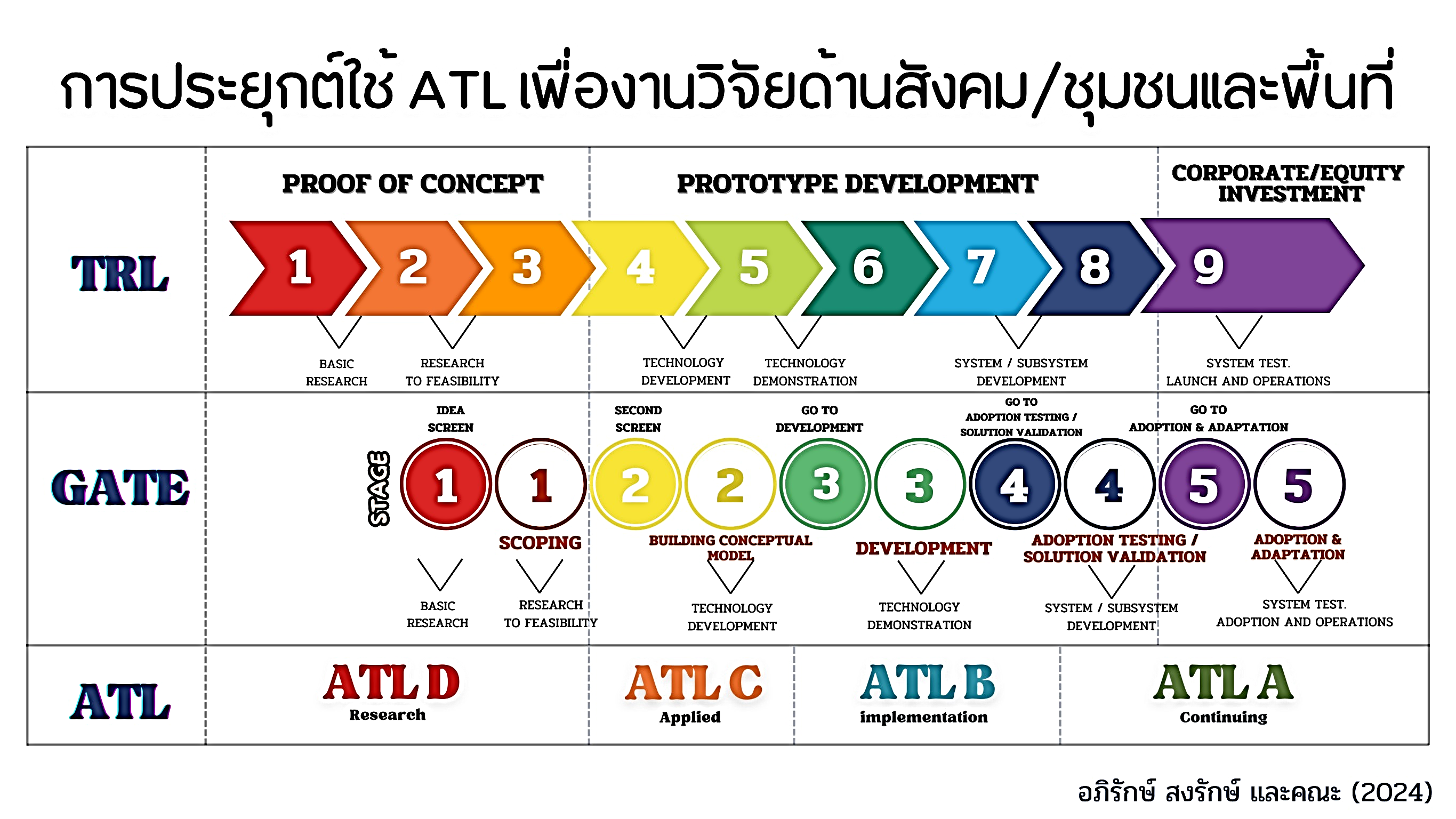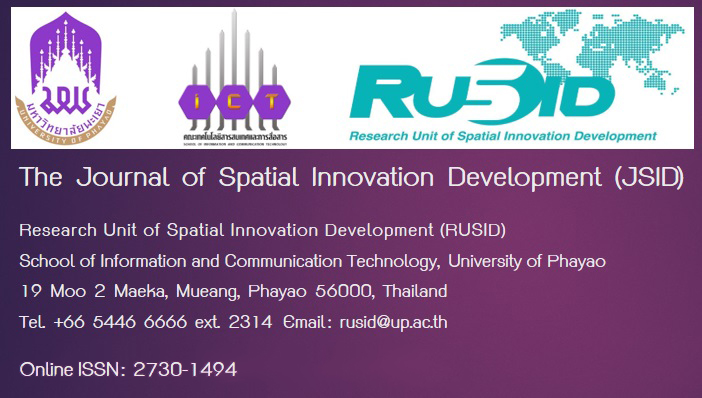Appropriate Technology-Level for Strategies Research Areas in Thailand
Keywords:
Appropriate Technology Level, Strategies Research Areas, Social MobilityAbstract
This article aims to evaluate the appropriate technology level for research funding and research funding sources. By applying the criteria and procedures for evaluating appropriate technology at 4 levels, namely ATL_D ATL_C ATL_B and ATL_A, the evaluation method must be accompanied by supporting documents from level ATL_D to complete ATL_B, and to tailor the appropriate technology level to suit the context of the research area by comparing the appropriate technology before it is applied to the research area and after it is applied to the research area. The evaluation method must also be accompanied by supporting documentation, which can adjust or reduce the appropriate technology level from the previously assessed level. It was found that when considering the strategic research area before and after the implementation, there were 59 and 60 technologies, an increase of 1 technology ATL_B. There was a significant increase in change from 9 technologies to 22 technologies, accounting for 244.4 percent. In conclusion, the important point is that the criterion for assessing the appropriate technology level is a new body of knowledge in the dimension of field research. It can be used to evaluate the appropriate technology to participate in the application for research funding. This assessment of the appropriate technology level can be a part of determining the readiness of future researchers.
References
จันธิมา อุทะกะ และ วิชชากร จารุศิริ. (2554). การประเมินทางเศรษฐศาสตร์และเทคโนโลยีที่เหมาะสมของการแปรรูปขยะเป็นน้ำมัน. วารสารมหาวิทยาลัยศรีนครินทรวิโรฒ (สาขาวิทยาศาสตร์และเทคโนโลยี), 3(2), 1-11.
ธนาคารพัฒนาเอเชีย. (2566). โรคระบาดส่งผลต่อความยากจนและสถานภาพทางสังคมในเอเชียอย่างน้อย 2 ปี. สืบค้นจาก https://www.adb.org/th/news/pandemic-sets-back-fight-against-poverty-asia-least-2-years.
ฐานเศรษฐกิจ. (2566). สศช.เปิดสถานการณ์ความยากจน-ความเหลื่อมล้ำ ประเทศไทย 2566. สืบค้นจาก https://www.thansettakij.com/business/economy/582085.
พีรเดช ทองอำไพ. (2567). เทคนิคและเครื่องมือการออกแบบงานวิจัยเพื่อหนุนเสริม Appropriate Technology แก้ปัญหาสังคม. การสัมมนาทางวิชาการ การประยุกต์ใช้เทคโนโลยีที่เหมาะสมเพื่อสร้างคุณภาพชีวิตที่ยั่งยืน, วันที่ 26–27 มีนาคม 2567. สงขลา: โรงแรมคริสตัล โฮเต็ล หาดใหญ่.
ระบบบริหารจัดการข้อมูลการพัฒนาคนแบบชี้เป้า. (2566). ภาพรวมคนจนในปี 2566 ประเทศไทย. สืบค้นจาก https://www.tpmap.in.th/2566.
วรางคณา ปัญญากรวงศ์, สุพัตรา ละออรัตนศักดิ์ และ สุดารัตน์ ลือพงศ์พัฒนะ. (2564). ประเมินระดับความพร้อมของเทคโนโลยีอย่างไรเมื่อต้องยื่นขอทุนวิจัย. วารสารสหวิทยาการ วิทยาลัยสหวิทยาการ มหาวิทยาลัยธรรมศาสตร์, 18(1), 12-63.
ศิรเดช สุริต และ กันติทัต ทับสุวรรณ. (2565). แนวทางการผลิตแผ่นดูดซับเสียงจากใยกัญชงด้วยเทคโนโลยีที่เหมาะสมในชุมชน. วารสารสังคมศาสตร์และมานุษยวิทยาเชิงพุทธ, 7(6), 1-16.
สุชาติ จันทรมณีย์ และคณะ. (2567). คู่มือการประเมินระดับเทคโนโลยีที่เหมาะสม (พิมพ์ครั้งที่ 3). สงขลา: โรงพิมพ์ไอคิว มีเดีย.
สุพิมพา วัฒนสังขโสภณ (2563) ศึกษาเทคโนโลยีที่เหมาะสมในการเกษตรปลอดสารสู่ชุมชนพึ่งตนเองของผู้สูงอายุในเขตชายแดนไทย-กัมพูชา จังหวัดสุรินทร์. วารสารเทคโนโลยีอุตสาหกรรม มหาวิทยาลัยราชภัฏอุบลราชธานี, 10(2), 75-88.
สหประชาชาติ ประเทศไทย. (2567). สาเหตุและผลกระทบของการเปลี่ยนแปลงสภาพภูมิอากาศ. สืบค้นจาก https://thailand.un.org/th/ 174652-สาเหตุและผลกระทบของการเปลี่ยนแปลงสภาพภูมิอากาศ.
สำนักงานพัฒนาวิทยาศาสตร์และเทคโนโลยีแห่งชาติ. (2559). คู่มือการประยุกต์ใช้การประเมินระดับความพร้อมของเทคโนโลยี. สืบค้นจาก https://www.nstda.or.th › allmedia › Category.
สำนักงานสถิติแห่งชาติ. (2565). การสำรวจการย้ายถิ่นของประชากร พ.ศ. 2565. สืบค้นจาก https://www.nso.go.th/nsoweb/storage/survey_detail/2024/20240308121915_47837.pdf.
อรุณี ชัยสวัสดิ์. (2566). การพัฒนาเทคโนโลยีที่เหมาะสมเป็นเทคโนโลยีที่ยั่งยืนของชุมชน. วิทยาศาสตร์และเทคโนโลยี, 38(1), 4-8.
Bishop, P. C. (2021). Sustainability lessons from appropriate technology. Current Opinion in Environmental Sustainability, (49), 50–56.
Kight, S. W., & Lysik, T. (2022). The human race at 8 billion. From: https://www.axios.com/2022/11/14/global-population-8-billion-data-world-humans-un.
Patnaik, J., & Bhowmick, B. (2018). Appropriate Technology: Revisiting the movement in developing countries for sustainability. International Scholarly and Scientific Research & Innovation, 12(3), 308-312.
Rex, P., Meenakshisundaram, M., & Barmavatu, P. (2024). Sustainable valorisation of kitchen waste through greenhouse solar drying and microwave pyrolysis– technology readiness level for the production of biochar. Journal of Environmental Health Science and Engineering, (22), 381–395.
Shin, H., Hwang, J., & Kim, H. (2019). Appropriate technology for grassroots innovation in developing countries for sustainable development: The case of Laos. Journal of Cleaner Production, 232. 1167-1175.
Sianipar, C. P. M. (2022). Environmentally-appropriate technology under lack of resources and knowledge: Solar-powered cocoa dryer in rural Nias, Indonesia. Cleaner Engineering and Technology, 8. 100494. From: https://doi.org/10.1016/j.clet.2022.100494.
Thamrong Prempridi. (1996). Appropriate Technology: Case Study of Shrimp Farming in Thailand and Vietnam. Science & Technology Asia, 1(1), 62–66.
UNESCO report. (2010). Engineering: issues, challenges and opportunities for development. France: UNESCO Publishing.
United Nations. (2015). UN projects world population to reach 8.5 billion by 2030, driven by growth in developing countries. From: https://www.un.org/sustainabledevelopment/blog/2015/07/un-projects-world-population-to-reach-8-5-billion-by-2030-driven-by-growth-in-developing-countries/.




